Examining Health Policy Access in the US and the ACA's Influence
VerifiedAdded on 2022/08/25
|5
|1222
|49
Report
AI Summary
This report analyzes the critical issues related to health policy access in the United States, focusing on realized, effective, and efficient access to healthcare. It identifies the lack of efficient access as a major problem, citing the high cost and inefficiency of the US healthcare system, along with disparities based on race, culture, ethnicity, and income. The report examines how the 2010 Affordable Care Act (ACA) attempted to address these issues by decreasing the cost of health insurance through premium tax credits and cost-sharing reductions. It highlights the ACA's success in reducing the uninsured rate and improving access to care and financial security, while also discussing the ACA's efforts to reform the payment system. The conclusion summarizes the key findings, emphasizing the importance of efficient access to healthcare policies in the U.S. and the role of the ACA in addressing these challenges.
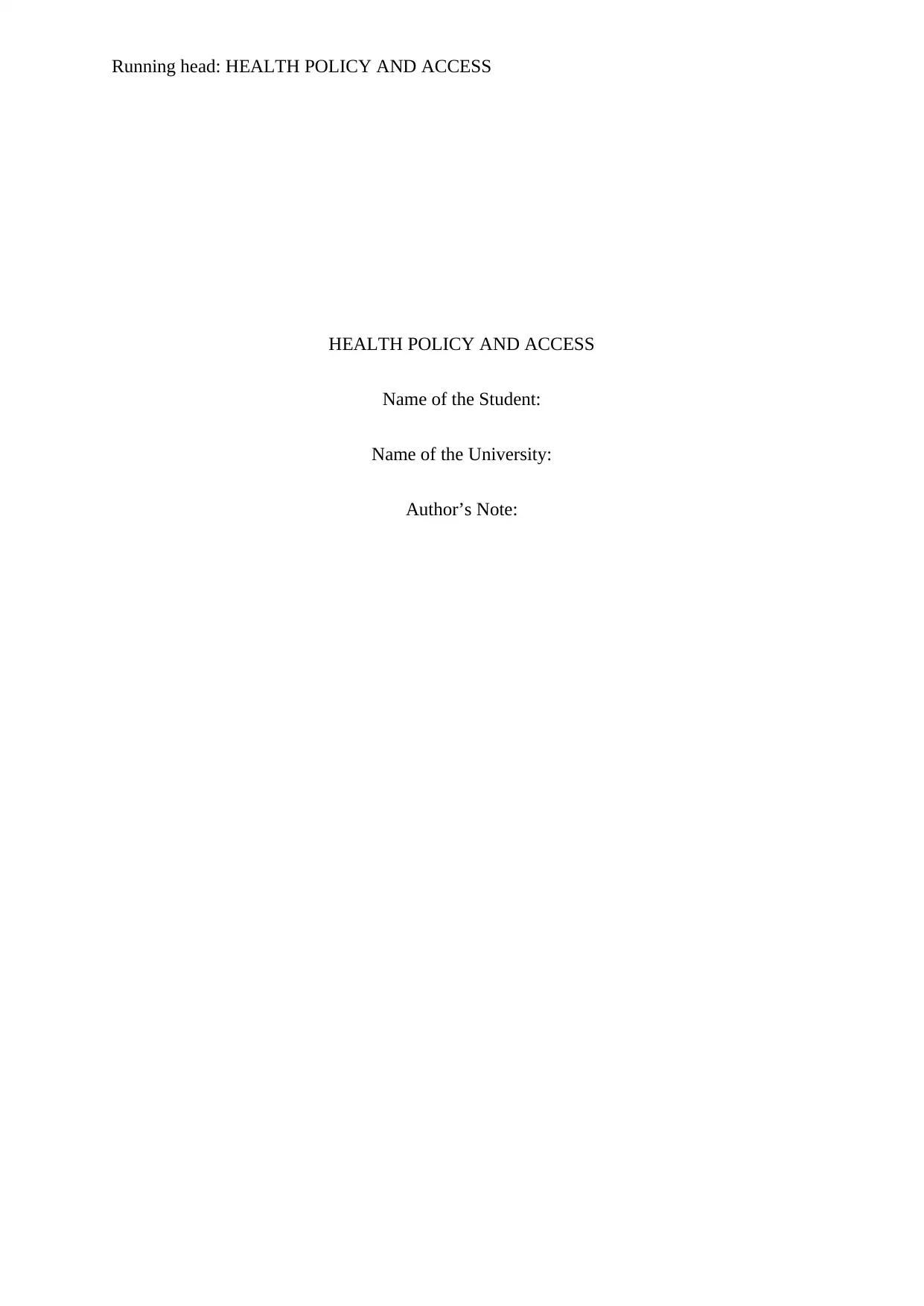
Running head: HEALTH POLICY AND ACCESS
HEALTH POLICY AND ACCESS
Name of the Student:
Name of the University:
Author’s Note:
HEALTH POLICY AND ACCESS
Name of the Student:
Name of the University:
Author’s Note:
Paraphrase This Document
Need a fresh take? Get an instant paraphrase of this document with our AI Paraphraser
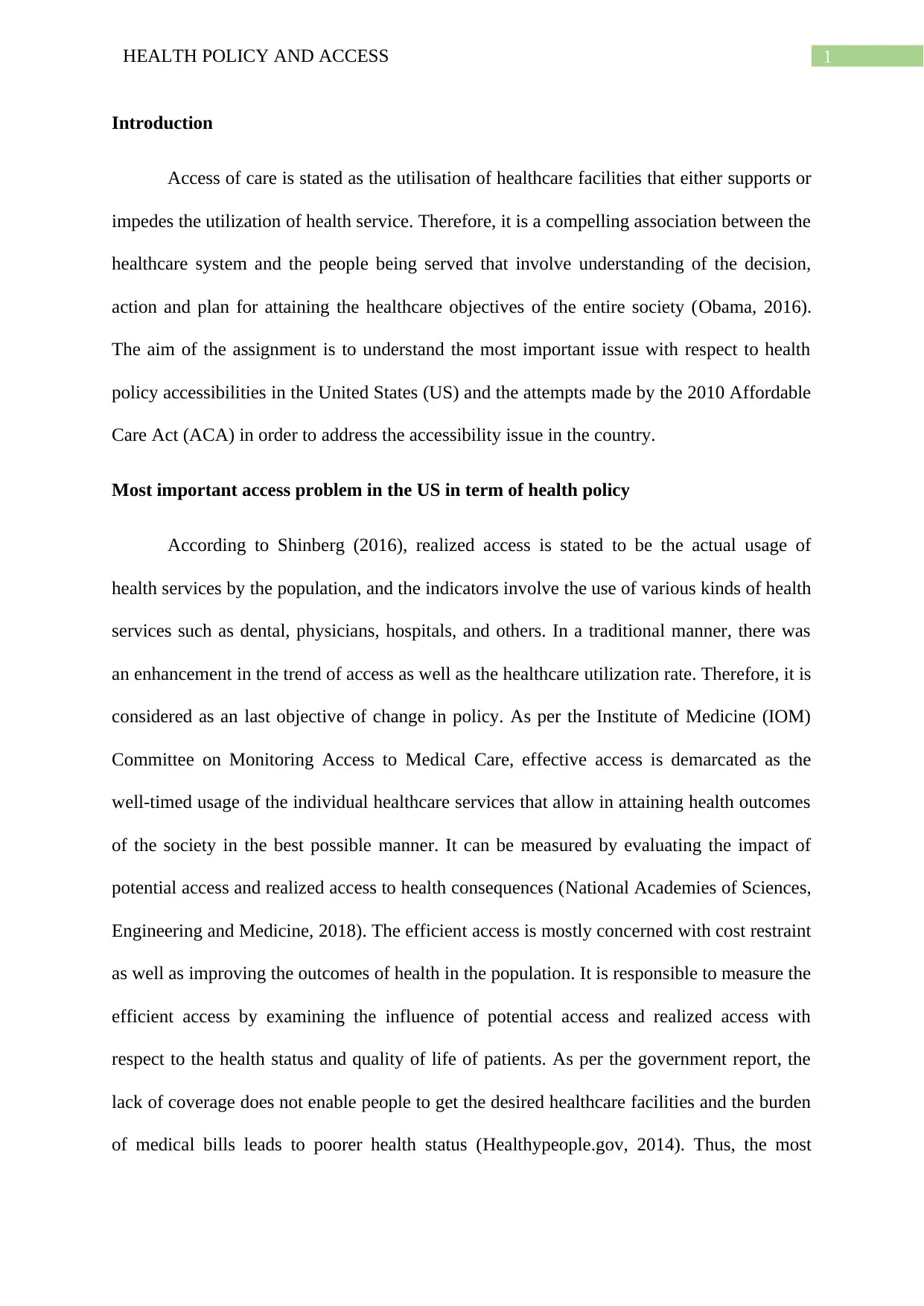
1HEALTH POLICY AND ACCESS
Introduction
Access of care is stated as the utilisation of healthcare facilities that either supports or
impedes the utilization of health service. Therefore, it is a compelling association between the
healthcare system and the people being served that involve understanding of the decision,
action and plan for attaining the healthcare objectives of the entire society (Obama, 2016).
The aim of the assignment is to understand the most important issue with respect to health
policy accessibilities in the United States (US) and the attempts made by the 2010 Affordable
Care Act (ACA) in order to address the accessibility issue in the country.
Most important access problem in the US in term of health policy
According to Shinberg (2016), realized access is stated to be the actual usage of
health services by the population, and the indicators involve the use of various kinds of health
services such as dental, physicians, hospitals, and others. In a traditional manner, there was
an enhancement in the trend of access as well as the healthcare utilization rate. Therefore, it is
considered as an last objective of change in policy. As per the Institute of Medicine (IOM)
Committee on Monitoring Access to Medical Care, effective access is demarcated as the
well-timed usage of the individual healthcare services that allow in attaining health outcomes
of the society in the best possible manner. It can be measured by evaluating the impact of
potential access and realized access to health consequences (National Academies of Sciences,
Engineering and Medicine, 2018). The efficient access is mostly concerned with cost restraint
as well as improving the outcomes of health in the population. It is responsible to measure the
efficient access by examining the influence of potential access and realized access with
respect to the health status and quality of life of patients. As per the government report, the
lack of coverage does not enable people to get the desired healthcare facilities and the burden
of medical bills leads to poorer health status (Healthypeople.gov, 2014). Thus, the most
Introduction
Access of care is stated as the utilisation of healthcare facilities that either supports or
impedes the utilization of health service. Therefore, it is a compelling association between the
healthcare system and the people being served that involve understanding of the decision,
action and plan for attaining the healthcare objectives of the entire society (Obama, 2016).
The aim of the assignment is to understand the most important issue with respect to health
policy accessibilities in the United States (US) and the attempts made by the 2010 Affordable
Care Act (ACA) in order to address the accessibility issue in the country.
Most important access problem in the US in term of health policy
According to Shinberg (2016), realized access is stated to be the actual usage of
health services by the population, and the indicators involve the use of various kinds of health
services such as dental, physicians, hospitals, and others. In a traditional manner, there was
an enhancement in the trend of access as well as the healthcare utilization rate. Therefore, it is
considered as an last objective of change in policy. As per the Institute of Medicine (IOM)
Committee on Monitoring Access to Medical Care, effective access is demarcated as the
well-timed usage of the individual healthcare services that allow in attaining health outcomes
of the society in the best possible manner. It can be measured by evaluating the impact of
potential access and realized access to health consequences (National Academies of Sciences,
Engineering and Medicine, 2018). The efficient access is mostly concerned with cost restraint
as well as improving the outcomes of health in the population. It is responsible to measure the
efficient access by examining the influence of potential access and realized access with
respect to the health status and quality of life of patients. As per the government report, the
lack of coverage does not enable people to get the desired healthcare facilities and the burden
of medical bills leads to poorer health status (Healthypeople.gov, 2014). Thus, the most
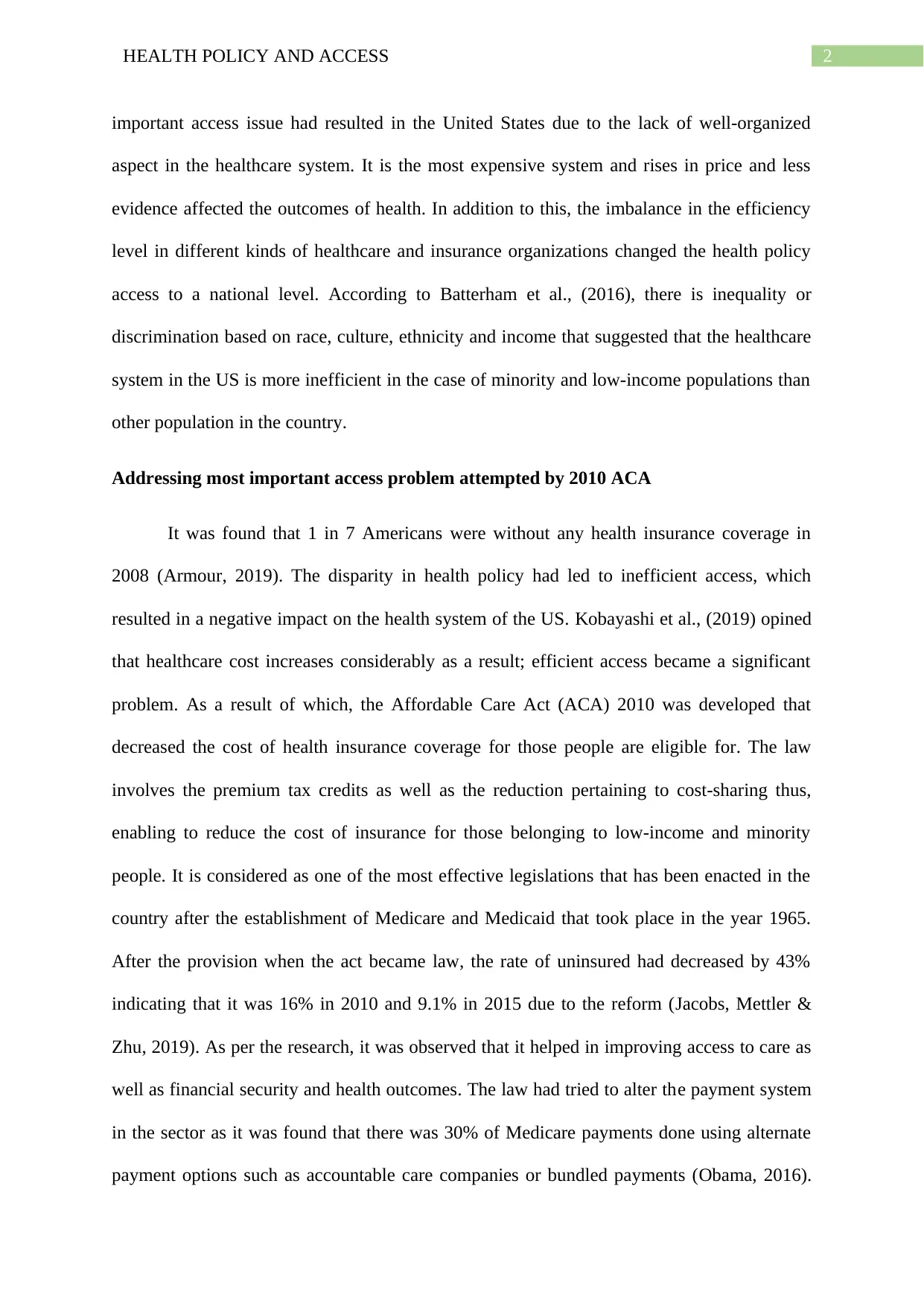
2HEALTH POLICY AND ACCESS
important access issue had resulted in the United States due to the lack of well-organized
aspect in the healthcare system. It is the most expensive system and rises in price and less
evidence affected the outcomes of health. In addition to this, the imbalance in the efficiency
level in different kinds of healthcare and insurance organizations changed the health policy
access to a national level. According to Batterham et al., (2016), there is inequality or
discrimination based on race, culture, ethnicity and income that suggested that the healthcare
system in the US is more inefficient in the case of minority and low-income populations than
other population in the country.
Addressing most important access problem attempted by 2010 ACA
It was found that 1 in 7 Americans were without any health insurance coverage in
2008 (Armour, 2019). The disparity in health policy had led to inefficient access, which
resulted in a negative impact on the health system of the US. Kobayashi et al., (2019) opined
that healthcare cost increases considerably as a result; efficient access became a significant
problem. As a result of which, the Affordable Care Act (ACA) 2010 was developed that
decreased the cost of health insurance coverage for those people are eligible for. The law
involves the premium tax credits as well as the reduction pertaining to cost-sharing thus,
enabling to reduce the cost of insurance for those belonging to low-income and minority
people. It is considered as one of the most effective legislations that has been enacted in the
country after the establishment of Medicare and Medicaid that took place in the year 1965.
After the provision when the act became law, the rate of uninsured had decreased by 43%
indicating that it was 16% in 2010 and 9.1% in 2015 due to the reform (Jacobs, Mettler &
Zhu, 2019). As per the research, it was observed that it helped in improving access to care as
well as financial security and health outcomes. The law had tried to alter the payment system
in the sector as it was found that there was 30% of Medicare payments done using alternate
payment options such as accountable care companies or bundled payments (Obama, 2016).
important access issue had resulted in the United States due to the lack of well-organized
aspect in the healthcare system. It is the most expensive system and rises in price and less
evidence affected the outcomes of health. In addition to this, the imbalance in the efficiency
level in different kinds of healthcare and insurance organizations changed the health policy
access to a national level. According to Batterham et al., (2016), there is inequality or
discrimination based on race, culture, ethnicity and income that suggested that the healthcare
system in the US is more inefficient in the case of minority and low-income populations than
other population in the country.
Addressing most important access problem attempted by 2010 ACA
It was found that 1 in 7 Americans were without any health insurance coverage in
2008 (Armour, 2019). The disparity in health policy had led to inefficient access, which
resulted in a negative impact on the health system of the US. Kobayashi et al., (2019) opined
that healthcare cost increases considerably as a result; efficient access became a significant
problem. As a result of which, the Affordable Care Act (ACA) 2010 was developed that
decreased the cost of health insurance coverage for those people are eligible for. The law
involves the premium tax credits as well as the reduction pertaining to cost-sharing thus,
enabling to reduce the cost of insurance for those belonging to low-income and minority
people. It is considered as one of the most effective legislations that has been enacted in the
country after the establishment of Medicare and Medicaid that took place in the year 1965.
After the provision when the act became law, the rate of uninsured had decreased by 43%
indicating that it was 16% in 2010 and 9.1% in 2015 due to the reform (Jacobs, Mettler &
Zhu, 2019). As per the research, it was observed that it helped in improving access to care as
well as financial security and health outcomes. The law had tried to alter the payment system
in the sector as it was found that there was 30% of Medicare payments done using alternate
payment options such as accountable care companies or bundled payments (Obama, 2016).
⊘ This is a preview!⊘
Do you want full access?
Subscribe today to unlock all pages.

Trusted by 1+ million students worldwide
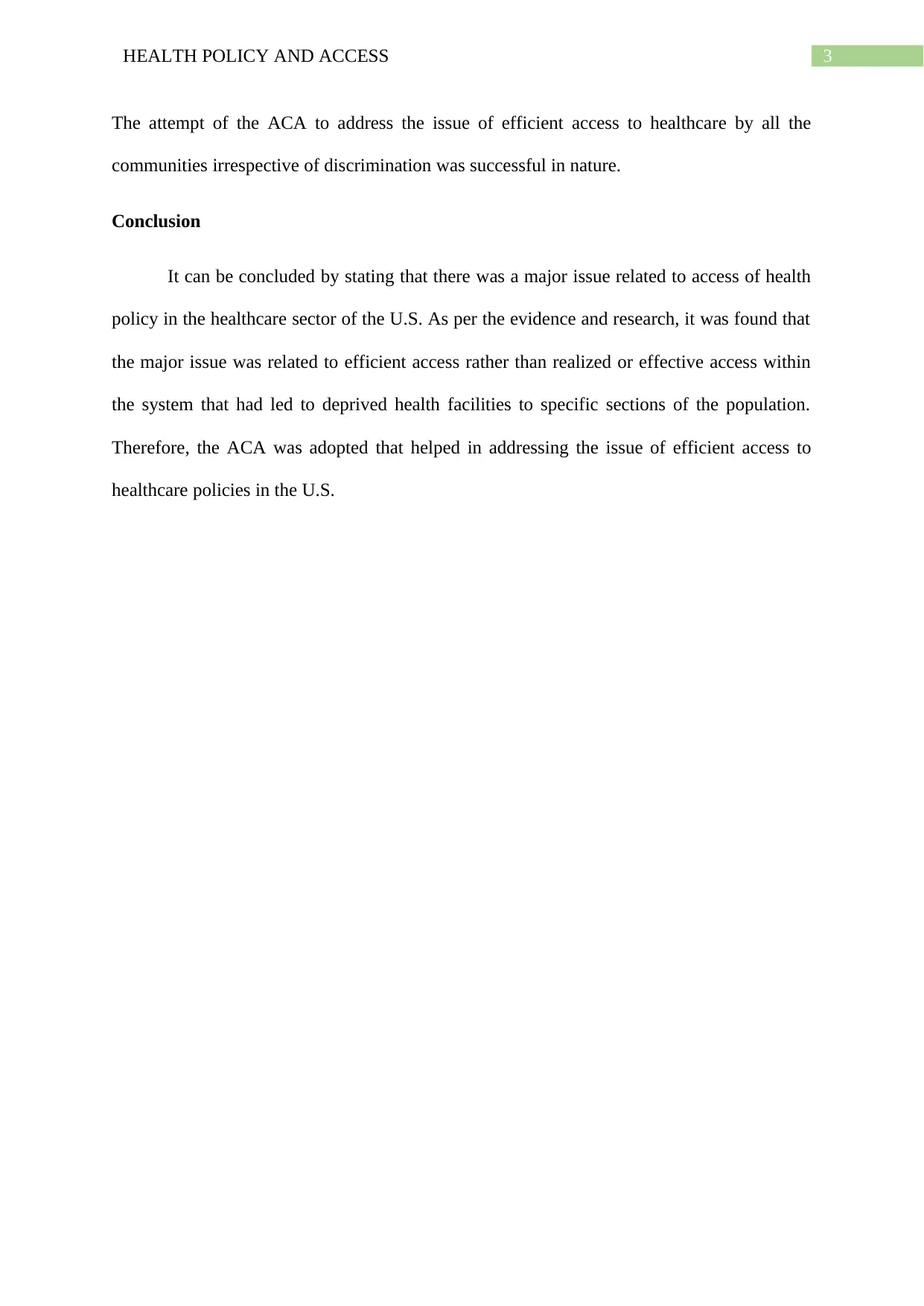
3HEALTH POLICY AND ACCESS
The attempt of the ACA to address the issue of efficient access to healthcare by all the
communities irrespective of discrimination was successful in nature.
Conclusion
It can be concluded by stating that there was a major issue related to access of health
policy in the healthcare sector of the U.S. As per the evidence and research, it was found that
the major issue was related to efficient access rather than realized or effective access within
the system that had led to deprived health facilities to specific sections of the population.
Therefore, the ACA was adopted that helped in addressing the issue of efficient access to
healthcare policies in the U.S.
The attempt of the ACA to address the issue of efficient access to healthcare by all the
communities irrespective of discrimination was successful in nature.
Conclusion
It can be concluded by stating that there was a major issue related to access of health
policy in the healthcare sector of the U.S. As per the evidence and research, it was found that
the major issue was related to efficient access rather than realized or effective access within
the system that had led to deprived health facilities to specific sections of the population.
Therefore, the ACA was adopted that helped in addressing the issue of efficient access to
healthcare policies in the U.S.
Paraphrase This Document
Need a fresh take? Get an instant paraphrase of this document with our AI Paraphraser
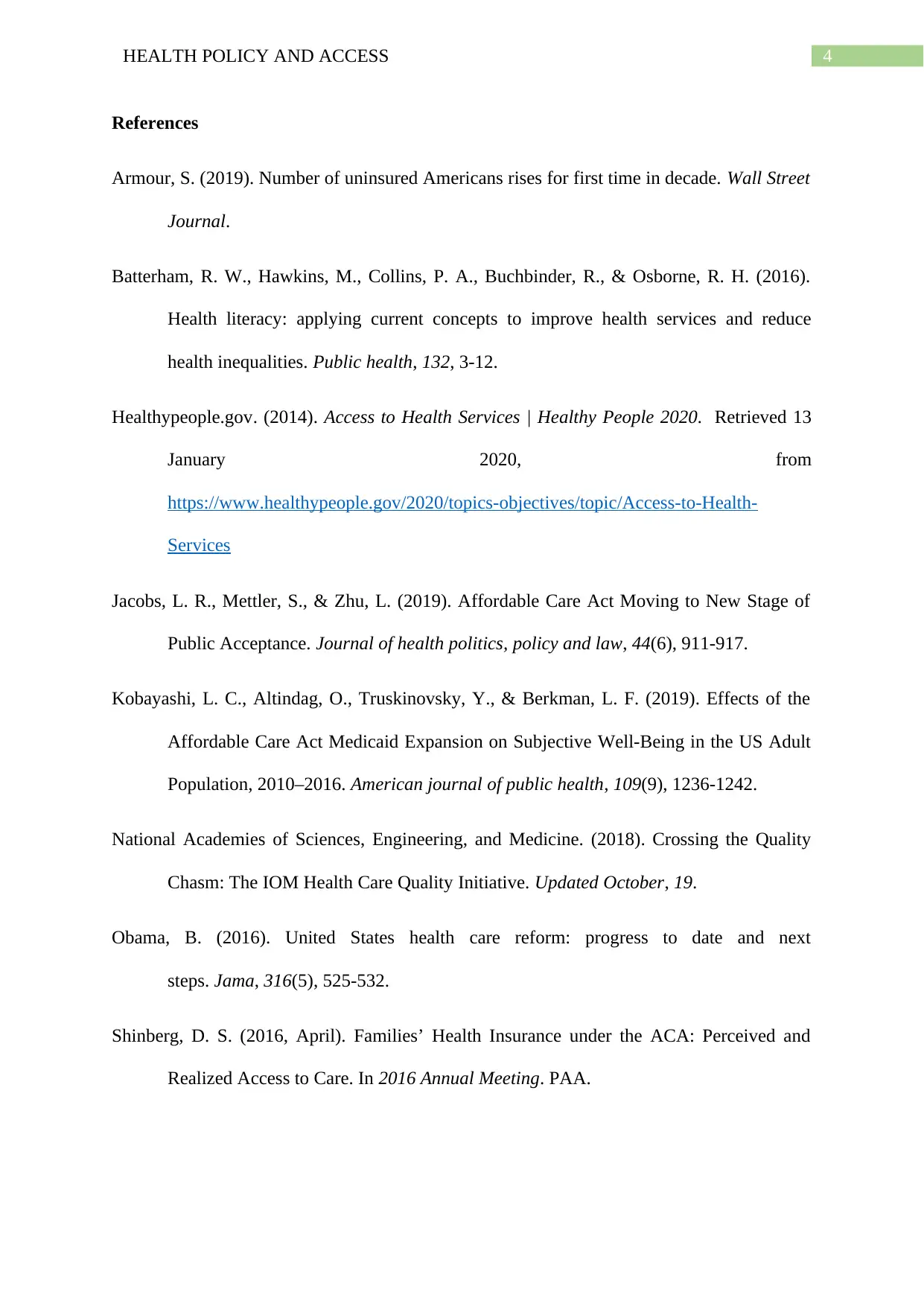
4HEALTH POLICY AND ACCESS
References
Armour, S. (2019). Number of uninsured Americans rises for first time in decade. Wall Street
Journal.
Batterham, R. W., Hawkins, M., Collins, P. A., Buchbinder, R., & Osborne, R. H. (2016).
Health literacy: applying current concepts to improve health services and reduce
health inequalities. Public health, 132, 3-12.
Healthypeople.gov. (2014). Access to Health Services | Healthy People 2020. Retrieved 13
January 2020, from
https://www.healthypeople.gov/2020/topics-objectives/topic/Access-to-Health-
Services
Jacobs, L. R., Mettler, S., & Zhu, L. (2019). Affordable Care Act Moving to New Stage of
Public Acceptance. Journal of health politics, policy and law, 44(6), 911-917.
Kobayashi, L. C., Altindag, O., Truskinovsky, Y., & Berkman, L. F. (2019). Effects of the
Affordable Care Act Medicaid Expansion on Subjective Well-Being in the US Adult
Population, 2010–2016. American journal of public health, 109(9), 1236-1242.
National Academies of Sciences, Engineering, and Medicine. (2018). Crossing the Quality
Chasm: The IOM Health Care Quality Initiative. Updated October, 19.
Obama, B. (2016). United States health care reform: progress to date and next
steps. Jama, 316(5), 525-532.
Shinberg, D. S. (2016, April). Families’ Health Insurance under the ACA: Perceived and
Realized Access to Care. In 2016 Annual Meeting. PAA.
References
Armour, S. (2019). Number of uninsured Americans rises for first time in decade. Wall Street
Journal.
Batterham, R. W., Hawkins, M., Collins, P. A., Buchbinder, R., & Osborne, R. H. (2016).
Health literacy: applying current concepts to improve health services and reduce
health inequalities. Public health, 132, 3-12.
Healthypeople.gov. (2014). Access to Health Services | Healthy People 2020. Retrieved 13
January 2020, from
https://www.healthypeople.gov/2020/topics-objectives/topic/Access-to-Health-
Services
Jacobs, L. R., Mettler, S., & Zhu, L. (2019). Affordable Care Act Moving to New Stage of
Public Acceptance. Journal of health politics, policy and law, 44(6), 911-917.
Kobayashi, L. C., Altindag, O., Truskinovsky, Y., & Berkman, L. F. (2019). Effects of the
Affordable Care Act Medicaid Expansion on Subjective Well-Being in the US Adult
Population, 2010–2016. American journal of public health, 109(9), 1236-1242.
National Academies of Sciences, Engineering, and Medicine. (2018). Crossing the Quality
Chasm: The IOM Health Care Quality Initiative. Updated October, 19.
Obama, B. (2016). United States health care reform: progress to date and next
steps. Jama, 316(5), 525-532.
Shinberg, D. S. (2016, April). Families’ Health Insurance under the ACA: Perceived and
Realized Access to Care. In 2016 Annual Meeting. PAA.
1 out of 5
Related Documents
Your All-in-One AI-Powered Toolkit for Academic Success.
+13062052269
info@desklib.com
Available 24*7 on WhatsApp / Email
![[object Object]](/_next/static/media/star-bottom.7253800d.svg)
Unlock your academic potential
Copyright © 2020–2025 A2Z Services. All Rights Reserved. Developed and managed by ZUCOL.





